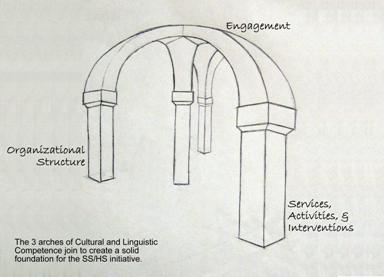CLC Toolkit
The goal of the Safe Schools/Healthy Students (SS/HS) Initiative is to support the positive development of children and families through the implementation of services, activities, and interventions based on a model of community collaboration.As culture is woven into the fabric of all communities, every SS/HS initiative, regardless of the location or demographic makeup of the communities it serves, can benefit from being culturally and linguistically competent. Cultural and linguistic competence (CLC) is a recognizable thread in all aspects of a successful SS/HS initiative. The effectiveness of an initiative is intrinsically connected to the development of CLC among its leaders as well as other community members.
 While working to create a framework for understanding CLC in the context of the SS/HS Initiative, we came upon an image from an unexpected source. This image came from central Turkey, where there are enormous underground Byzantine churches and caves.
While working to create a framework for understanding CLC in the context of the SS/HS Initiative, we came upon an image from an unexpected source. This image came from central Turkey, where there are enormous underground Byzantine churches and caves.
These underground spaces are not only beautiful, but also provide a foundation for the communities that rest above them. The architects discovered that while an individual arch could not sustain the weight of the city above, three arches joined together could provide the necessary strength. This model of intertwined and connecting supports inspired us to envision a way of thinking about CLC as it relates to the SS/HS Initiative.
Thinking in this way, the three “arches” of CLC in the context of SS/HS are:
- Organizational Structure
- Engagement
- Services/Activites/Interventions
 By building up and connecting these three key areas, the Initiative can create a solid foundation to serve the community in a culturally competent manner that promotes safer schools and healthier students, families and communities.
By building up and connecting these three key areas, the Initiative can create a solid foundation to serve the community in a culturally competent manner that promotes safer schools and healthier students, families and communities.
Strength in these three arches allows Initiatives to conduct the continuum of activities involved in cultural and linguistic competence: needs assessment, planning, and identification of appropriate services; service delivery and implementation of activities and interventions. “Unlearning” the biases and stereotypes that have been acquired over time, in order to be open to the acquisition of new information, knowledge, and wisdom, is often the first step in developing these strengths. This in turn leads to a broader perspective that will enhance our ability to recognize needs, address challenges, celebrate strengths, and provide services to diverse communities.
Everyone has a voice, and everyone deserves to be heard. Inclusion of multiple perspectives is critical to the full engagement of all segments of the population, which enriches and benefits not only the subgroups, but the community as a whole. However, the effectiveness of this Initiative will depend on a clear understanding of the needs of the community and how to engage the students and parents who reside there. The ability to implement effective programs and obtain an understanding of the nuances of each community depends on an organizational structure that strives to become increasingly culturally competent. Therefore, having a culturally competent organizational structure, culturally competent engagement strategies, and culturally competent services, activities, and interventions will foster the positive development of all children and families. Developing cultural and linguistic competency is a learning process that requires us to open our minds to a new way of looking at the world. This learning process will of necessity include examining and coming to terms with the individual and institutional racism that affects some of our community members.
